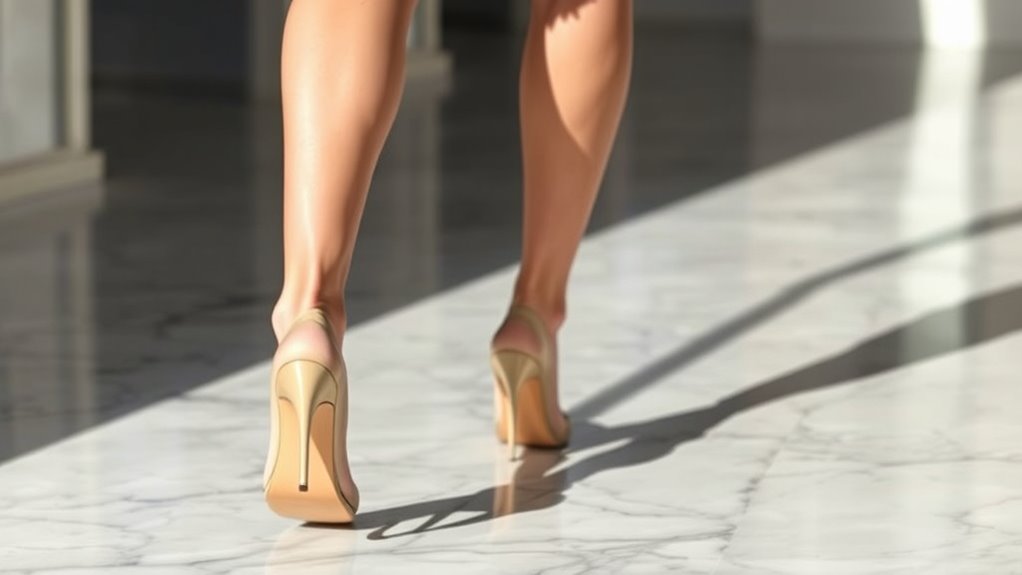Wearing high heels shifts your center of gravity, altering your walking mechanics considerably. This change leads to shorter, more deliberate steps, and an exaggerated curvature in your lower back due to compensation. The resultant pelvic tilt increases pressure on your spine, while your feet may suffer from bunions and plantar fasciitis. Over time, these factors can lead to chronic pain and muscle imbalances. Explore further to understand more about maintaining comfort and preventing long-term issues.
The Mechanics of Walking in High Heels

When you slip on a pair of high heels, the mechanics of your walk change considerably due to the altered angle of your foot. The increased heel height shifts your center of gravity, forcing your body to adapt to maintain balance. You may find yourself employing specific balance techniques, such as engaging your core muscles and adjusting your stride length. These adaptations are essential for stability, as the narrow base of the heel provides less surface area for support compared to flat shoes.
As you walk, your ankle flexes more, which can lead to variations in your gait. You might notice that your steps become shorter and more deliberate to prevent wobbling. This change in movement not only affects your overall walking pattern but also influences how your weight is distributed. Understanding these mechanics can help you navigate the nuances of walking in high heels while minimizing discomfort and reducing the risk of injury.
Impact on Posture and Spine Alignment
Although high heels can enhance your appearance, they greatly impact posture and spine alignment. Wearing heels induces significant postural changes, shifting your center of gravity forward. This forces your body to compensate, often leading to an exaggerated lumbar curve, which can affect overall spinal curvature. Your pelvis tilts anteriorly, increasing pressure on the lower back and potentially causing discomfort over time.
As you adapt to this altered posture, the muscles in your back and abdomen may weaken, while those in the hips and legs become overactive. This imbalance can exacerbate strain on the spine, making it vital to be aware of how high heels influence your alignment. Regularly wearing high heels can lead to long-term complications, so consider limiting their use or incorporating exercises that promote spinal health and postural stability. Understanding these impacts is essential for maintaining your overall well-being.
Common Foot and Leg Issues Associated With High Heels

While high heels may elevate your style, they often lead to a variety of foot and leg issues that can compromise comfort and mobility. The biomechanics involved in high heel wear can cause several problems, including:
- Bunions formation: The pressure on the toes can distort their alignment, leading to painful bunions.
- Ankle instability: Elevated heels shift your body weight forward, increasing the risk of sprains and instability.
- Plantar fasciitis: The altered foot position can strain the plantar fascia, causing heel pain.
- Metatarsalgia: High heels concentrate weight on the balls of your feet, resulting in inflammation and discomfort.
These conditions not only affect your immediate comfort but can also impact your overall gait and posture. Being aware of these risks can help you make informed choices about your footwear and prioritize your foot health.
Long-Term Consequences of Frequent High Heel Use
Frequent high heel use can lead to significant long-term consequences that extend beyond immediate discomfort and aesthetics. Over time, your body adapts to the altered biomechanics imposed by elevated heels, resulting in chronic pain in the feet, knees, and lower back. These shoes force your foot into an unnatural position, which can contribute to muscle imbalances. Specifically, the calf muscles may tighten while the muscles in the anterior leg weaken, leading to further postural issues.
Additionally, the altered gait mechanics can increase stress on the joints, potentially leading to degenerative conditions like osteoarthritis. These long-term consequences not only affect your physical comfort but can also have implications for mobility and overall quality of life. It’s essential to recognize that the persistent use of high heels can create a cycle of chronic pain and discomfort, making it vital to evaluate your footwear choices for long-term health.
Tips for Maintaining Comfort While Wearing High Heels

To mitigate the discomfort associated with wearing high heels, implementing effective strategies can greatly enhance your experience. Here are some tips to maintain comfort:
- Choose the Right Shoe Selection: Opt for heels with a wider toe box and adequate cushioning to minimize pressure on your feet.
- Use Heel Inserts: Consider gel heel inserts or arch supports to provide extra comfort and support, reducing impact on your heels.
- Limit Wear Time: Alternate between high heels and more comfortable footwear throughout the day to give your feet a break.
- Practice Good Posture: Maintain a neutral spine and engage your core while walking, which can alleviate strain on your feet and lower back.
Frequently Asked Questions
How Do High Heels Affect a Woman’s Confidence and Self-Esteem?
High heels can provide a confidence boost by altering your perception of self-image. However, self-esteem factors vary; while some women feel empowered, others may experience discomfort, affecting their overall confidence and how they carry themselves.
Are There Specific High Heel Styles That Are Less Harmful?
When choosing high heels, consider block heels for their benefits like better weight distribution and stability. Wedge heels also provide stability, reducing strain on your feet and promoting a more comfortable wearing experience overall.
Can High Heels Impact a Woman’s Gait Over Time?
Like a dancer’s rhythm, your gait can change over time due to high heels. Gait analysis shows that prolonged use may lead to long-term effects, altering biomechanics and potentially causing discomfort or injury in the future.
Do High Heels Influence a Woman’s Social Interactions?
High heels can greatly influence a woman’s social interactions by altering social dynamics and body language. They often project confidence, leading to increased attention, while also affecting how others perceive your authority and presence in various situations.
Are There Alternatives to High Heels That Provide a Similar Aesthetic?
Consider a study where women preferred block heeled boots or stylish flats for comfort without sacrificing aesthetics. These alternatives offer height and style, ensuring you can maintain a fashionable look while prioritizing foot health.



